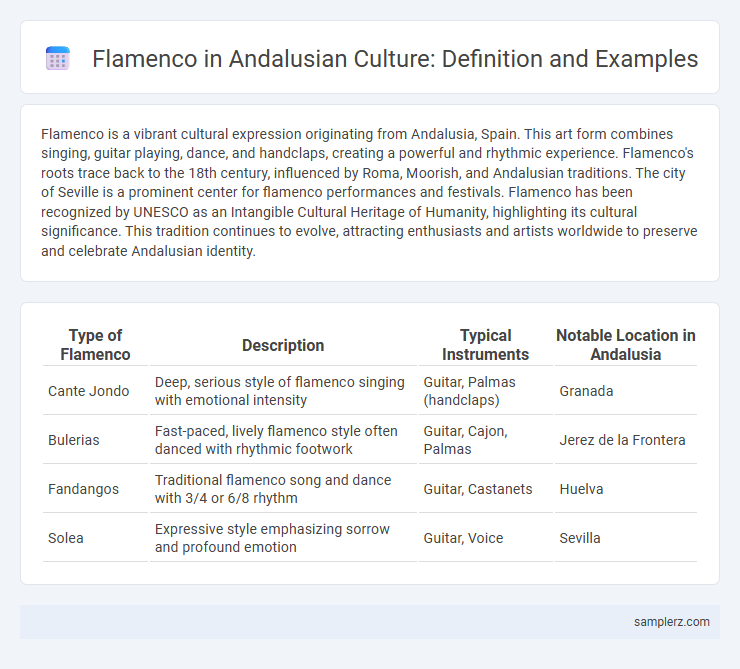Flamenco is a vibrant cultural expression originating from Andalusia, Spain. This art form combines singing, guitar playing, dance, and handclaps, creating a powerful and rhythmic experience. Flamenco's roots trace back to the 18th century, influenced by Roma, Moorish, and Andalusian traditions. The city of Seville is a prominent center for flamenco performances and festivals. Flamenco has been recognized by UNESCO as an Intangible Cultural Heritage of Humanity, highlighting its cultural significance. This tradition continues to evolve, attracting enthusiasts and artists worldwide to preserve and celebrate Andalusian identity.
Table of Comparison
| Type of Flamenco | Description | Typical Instruments | Notable Location in Andalusia |
|---|---|---|---|
| Cante Jondo | Deep, serious style of flamenco singing with emotional intensity | Guitar, Palmas (handclaps) | Granada |
| Bulerias | Fast-paced, lively flamenco style often danced with rhythmic footwork | Guitar, Cajon, Palmas | Jerez de la Frontera |
| Fandangos | Traditional flamenco song and dance with 3/4 or 6/8 rhythm | Guitar, Castanets | Huelva |
| Solea | Expressive style emphasizing sorrow and profound emotion | Guitar, Voice | Sevilla |
Introduction to Flamenco: The Heartbeat of Andalusia
Flamenco, originating from Andalusia, is a vibrant expression of music, dance, and singing that captures the region's rich cultural heritage. Rooted in the diverse influences of Gypsy, Moorish, and Andalusian traditions, flamenco reflects deep emotional intensity and storytelling through distinctive rhythms and passionate performances. The art form's iconic guitar playing, heartfelt vocals, and intricate footwork make flamenco the cultural heartbeat of Andalusia, celebrated worldwide for its authenticity and soul.
Historical Roots of Flamenco in Andalusia
Flamenco in Andalusia traces its historical roots to the diverse cultural influences of the region, including Gypsy, Moorish, Jewish, and Andalusian folk traditions. This unique art form emerged in the 18th century as a passionate expression of marginalized communities, blending singing (cante), guitar playing (toque), and dance (baile). The city of Seville remains a key center for preserving and evolving flamenco's rich heritage.
The Key Elements: Song, Dance, and Guitar
Flamenco in Andalusia is characterized by its powerful fusion of cante (song), baile (dance), and toque (guitar playing), each element essential to the art form's emotional depth. The cante delivers intense, soulful vocals often conveying themes of passion and sorrow, while the baile incorporates intricate footwork and expressive body movements to interpret the music visually. The guitar provides rhythmic complexity and melodic richness, serving as both accompaniment and solo instrument that drives the overall performance.
Iconic Flamenco Venues in Andalusia
Seville's Casa de la Memoria and Granada's Pena La Plateria stand as iconic flamenco venues in Andalusia, showcasing authentic performances deeply rooted in regional tradition. The Corral de la Moreria in Madrid, although outside Andalusia, often features Andalusian artists, highlighting the cultural exchange within flamenco circuits. These venues preserve the art form's emotional intensity and complex rhythms, drawing global audiences to experience genuine Andalusian flamenco heritage.
Renowned Flamenco Festivals in Southern Spain
Renowned Flamenco festivals in Andalusia, such as the Festival de Jerez and the Bienal de Flamenco in Seville, showcase the rich heritage and passionate performances that define flamenco culture. These events attract top dancers, singers, and guitarists from across Spain and the world, preserving traditional styles while promoting contemporary innovation. The festivals significantly contribute to the local economy and cultural tourism, highlighting Andalusia as the epicenter of flamenco art.
Legendary Flamenco Artists from Andalusia
Legendary Flamenco artists from Andalusia, such as Paco de Lucia, Camaron de la Isla, and Vicente Amigo, have profoundly shaped the cultural identity of the region through their innovative guitar techniques and passionate vocal performances. Their contributions have preserved and elevated traditional flamenco, blending deep emotional expression with technical mastery that continues to influence contemporary flamenco music globally. Andalusia remains a vibrant hub for flamenco, where these iconic figures' legacies inspire new generations of performers and enthusiasts.
The Influence of Andalusian Gypsy Culture
Flamenco, a vibrant art form rooted in Andalusia, reflects the profound influence of Andalusian Gypsy culture through its passionate singing, intricate guitar rhythms, and expressive dance movements. The Gypsies contributed unique vocal styles known as "cante jondo," characterized by deep emotional intensity and spiritual themes, which have become central to flamenco's identity. This cultural fusion highlights the resilience and creativity of the Andalusian Gypsy community, shaping flamenco as a symbol of regional heritage and global cultural expression.
Flamenco in Andalusian Daily Life
Flamenco in Andalusian daily life serves as a vibrant expression of cultural identity, deeply rooted in the region's history and social fabric. This art form permeates everyday activities, with spontaneous singing (cante), guitar playing (toque), and dance (baile) often occurring in family gatherings, local festivals, and community celebrations. Flamenco's presence in Andalusia fosters social cohesion and preserves traditional narratives, reflecting the diverse influences of Roma, Moorish, and Jewish heritage.
Culinary Experiences at Flamenco Events
Flamenco events in Andalusia often feature traditional tapas such as jamon iberico, Manchego cheese, and patatas bravas, enhancing the immersive cultural experience. Local wines like Rioja and sherry from Jerez complement the vibrant flamenco performances, creating a sensory blend of taste and sound. Culinary experiences at these events highlight Andalusian heritage, pairing authentic flavors with the passionate rhythm of flamenco music and dance.
Preserving Flamenco Traditions for Future Generations
Flamenco in Andalusia remains a vibrant cultural heritage with dedicated institutions and local communities committed to preserving its traditional music, dance, and song. Workshops and festivals throughout the region educate young artists in the art's historical techniques, ensuring transmission of authentic styles and emotional expression. Government support and UNESCO recognition as Intangible Cultural Heritage further strengthen initiatives that protect and promote Flamenco's legacy for future generations.

example of flamenco in Andalusia Infographic
 samplerz.com
samplerz.com